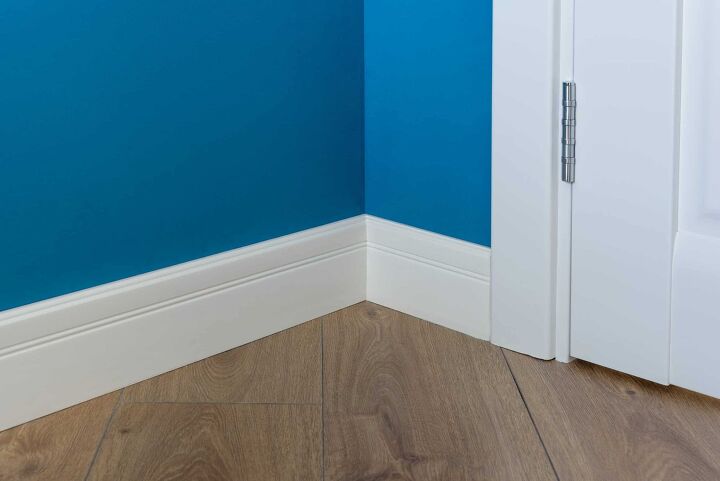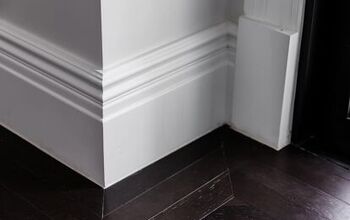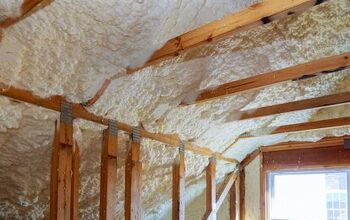Should Your Baseboards Match Your Door Trim?

Baseboards and door trim are important elements in any home. Without them, walls can feel unfinished or cheap. They also serve a functional purpose of hiding gaps between the wall and doorjamb or floor.
Your baseboards do not have to match your door trim. Though it provides a consistent and more traditional aesthetic, it is a rule that you should feel free to break. Baseboards and door trim are great places to add a unique flair to any room.
Traditionally, baseboards and door trim have been ignored in interior design. They have been painted white to blend in and leave focus to the walls and flooring. However, there are many reasons why you might break the mold and choose a different look. If you’re willing to be different, there are tons of exciting options to consider.
Do You Need Handyman Services?
Get free, zero-commitment quotes from pro contractors near you.

Consistency Vs. Contrast
There are so many decisions to make when designing or remodeling a room. You may prioritize picking out furniture or light fixtures. It is easy to forget about baseboards and door trims. But these important interior design elements will affect the overall feel of your space.
White on White
If you are settled on white walls, you might decide to just make everything match. Baseboards, door trim, walls, and ceiling: why not keep it consistent? It is the easiest to paint, and you wouldn’t be faulted for cutting corners on these seemingly unimportant decisions. It is also an extremely clean, and therefore modern, look.
If you have a small space, white on white is a great way to make a room look larger. In apartments or tiny homes, it can make a lot of sense. Colors pop, and the visual emptiness of white provides extra breathing room. Additionally, if you have something you want to keep focus on, like art or furniture, white won’t detract from it.
Bolder Options
But not everything needs to match! If you are struggling with a dull room that needs to be spiced up, this is a great way to do it. Painting baseboards is a simpler, cheaper, and faster way to give your room character than painting a whole wall.
For example, consider matching a wooden door trim to just your hardwood floors. Paint your baseboards and walls to match, white, or a subtle, neutral tone. This is a great way to make your door stand out. The contrasting door trim will look like a frame and invite you to move into the next room. This design accentuates natural timbers and establishes movement between rooms of your home.
You can also choose to match your baseboards with the floor and the trim with the door. This will create a color-blocking effect. This visual distinction can really help make small spaces feel bigger because your eye will see them as discrete features.
Colors and Contrast
No matter what you choose to match or contrast, you can do so with a variety of colors or wood stains. If you choose light and neutral colors that complement each other, your baseboards and trim will blend peacefully. Grays can be used for a traditional aesthetic, while pastels create an airy, seaside look.
However, you might opt for dark on light, and this high contrast is a very modern, luxurious design. Earth tones are a creative way to add warmth to a space, and black will look sleek and sophisticated. Below is a more detailed examination of these color choices to help you decide which palette is right for you.
What Color Should You Paint Your Trim?
What Different Trim Colors Are There?
If you are looking for an eclectic, colorful interior design, the sky is the limit. Literally, any color under the rainbow. Below, we look at these different options and the feel they will create in your space.
Style | Color Options | Feel | Is It Right for Me? |
| White/Off-white | Paint color to match walls | This classic look is very subtle and provides a cohesive, safe design palette. | If you have statement furniture pieces or wall art, you may want not want your trim to detract from these. |
| Neutral tones | Beige, gray, taupe | A small step into the modern while maintaining a more traditional aesthetic. | If you prefer empty, white walls, a slightly darker trim will break up the sightline disturbing the peaceful aesthetic. |
| Wood | Stain to match floors, if applicable | Wood baseboards and door trim provide a warm, rustic vibe. | If you wish you lived in a cabin and prize natural timbers and indoor plants, wood on your walls is the style for you. |
| Black | Iron, black satin, onyx | This dramatic choice creates high-contrast for a sophisticated and fashionable look. | If your space is otherwise filled with light colors and airy design, black baseboards can help a room feel grounded. And if you have lower ceilings, black crown molding can draw the eye up, creating an illusion of height. |
| Colorful | Darks: olive green, navy blue, brick red Lights: peach, lemon, lilac | Go bold for an eclectic and playful style. Match a statement furniture piece to emphasize it and create a consistent color palette. | If you have detailed, ornamental trim, you should draw attention to it! This small pop of color is also cheaper and easier than painting a whole wall. |
Do You Need Handyman Services?
Get free, zero-commitment quotes from pro contractors near you.

Related Questions
Does baseboard trim need to match throughout my house?
There are a lot of different styles of baseboard trim. You can pick a flat or slim baseboard design for a more modern, minimalist accent. Or you can install an ornate and art baseboard that will compliment beautiful hardwood flooring. There is even base trim to hide gaps between your baseboards and floors.In most designs, baseboards are consistent throughout homes in order to provide clean flow between rooms. This is a very safe style that will keep you at ease while walking from room to room. However, you may want a room that wakes you up when you walk into it. Bold and exciting baseboard trim can do just this because it is an unexpected place to add design flair.
Should my baseboards and crown molding match?
Typically, baseboards and crown molding are painted the same color to provide a consistent frame around your walls. However, wide, decorative crown molding can make a room feel very upscale and sophisticated. Once you’ve installed your gorgeously detailed crown molding, you will want to give it some attention.Crown molding can also serve to frame a unique ceiling. A dark ceiling is a great way to create an intimate feel in a space. A timber ceiling, say with exposed beams, is a statement that deserves all the attention. In either of these cases, you would want subtle crown molding that blends in. But this doesn’t necessarily mean your baseboards need to hide, too.
What type of paint is best for my baseboards?
We suggest using a water-based or acrylic paint with semi-gloss or high-gloss sheen. Glossy paint is best on baseboards because it is more resistant to dirt and scuff marks. Since baseboards take a lot of damage over time, this is an important consideration. Especially if you have kids or pets in your home, a low-gloss paint will look worn out a lot faster.
Related Guides

Benjamin is a freelance writer and graphic designer. He is passionate about DIY projects and finding creative ways to upcycle things headed for the landfill. Based in Oakland, CA, Benjamin enjoys playing guitar and gardening.
More by Benjamin Panico













![10 Best Electric Pressure Washers – [2022 Reviews & Guide]](https://cdn-fastly.upgradedhome.com/media/2023/07/31/9070600/10-best-electric-pressure-washers-2022-reviews-guide.jpg?size=350x220)













